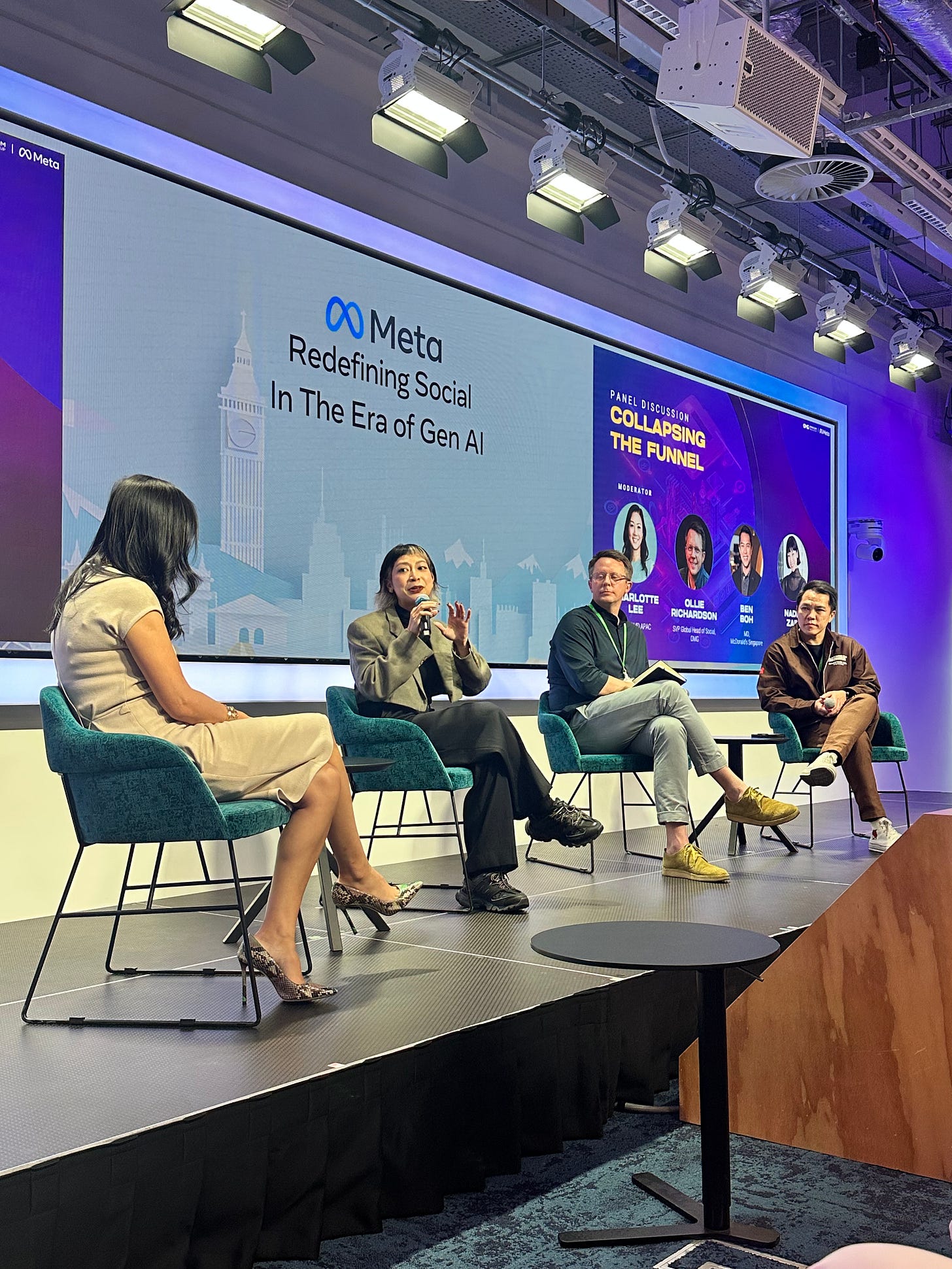McDonald's MD on why most brands fail at social commerce and how to fix it
Waiting for awareness to turn into sales is passe. With discovery, engagement, and conversion happening within a single scroll, social commerce is changing how brands connect with consumers.
I walked into Omnicom Media Group and Meta’s From Content to Commerce: Redefining Social in the Gen AI Era with a keen curiosity about how social commerce reshapes marketing.
The days of linear, rigid marketing funnels seem long gone. They have been replaced by an era in which discovery, consideration, and conversion happen in a single impression.
The panel discussion, featuring Charlotte Lee (CEO, OMD APAC), Nadia Zain (agency partner, Meta Indonesia), Ollie Richardson (SVP global head of social, Omnicom Media Group), and Ben Boh (managing director, McDonald’s Singapore and president, Singapore Restaurant Association), detailed this shift.
From awareness to conversion in a single scroll
Lee opened with a striking reflection on the past: “I remember when media plans required months to move from awareness to consideration and then to conversion. Now, all of that happens within a single impression.”
That is the reality of today’s social commerce landscape. AI-driven personalisation means that every ad a user sees is tailored to their interests, compressing the traditional purchase funnel. Social media enables instant action, not just inspiration.
The moment users see a product, they can engage, evaluate, and buy on the same platform within seconds.
The power of social commerce for brands
Boh from McDonald’s Singapore emphasised how digital acceleration has transformed consumer decision-making.
“People don’t make decisions about what to eat when they arrive at a mall anymore. They’ve already decided before they step out the door,” said Boh.
He described how McDonald’s leverages social commerce to engage customers long before they even consider a meal. From limited-edition drops to community-driven content, the brand has turned its social presence into a key revenue driver.
“If people are talking about us, whether it’s a new menu item or a collector’s item, we’ve succeeded in embedding ourselves into their everyday digital conversations.”
This highlights a fundamental shift that brands can no longer afford to be passive observers in social spaces. They must be active participants, engaging customers through hyper-relevant, real-time content.
Video and creators: The heart of social commerce
Richardson weighed in on the role of content in driving commerce. “Video is no longer just a brand awareness tool. It’s a direct sales driver.”
He pointed to the explosion of creator-led commerce, in which influencers not only recommend products but also co-create them with brands.
“We are seeing McDonald’s collaborate with creators to develop new menu items, fashion brands co-launch collections with TikTok influencers, and even finance brands integrating creator content into their sales funnels.”
The key takeaway is that social commerce is about embedding brand narratives within the content they consume and not about interrupting consumers with ads. Creators play a crucial role in making this transition seamless.
The infrastructure behind the magic
Of course, none of this happens without a strong foundation. Richardson emphasised the often-overlooked backend of social commerce, the data, infrastructure, and AI models that power personalisation.
“Everything from conversion APIs to predictive analytics plays a role in ensuring that the right content reaches the right consumer at the right time. The best consumer-facing experiences are built on sophisticated backend systems.”
It is a crucial reminder that social commerce is about more than creative storytelling; it is also about operational excellence. Without the right data and automation, brands risk losing relevance in an increasingly competitive space.
Hyper-localisation: The competitive advantage in APAC
A key theme of the discussion was the role of cultural nuances in shaping social commerce strategies. “APAC is not a monolithic market,” Boh stressed. You can’t take a one-size-fits-all approach.”
McDonald’s, for example, adapts its menu, promotions, and even digital engagement strategies to resonate with local audiences. “A campaign in Singapore may not work in Indonesia or Vietnam. We tailor every aspect, from the creative execution to the payment options, to ensure relevance.”
This hyper-localisation strategy is a critical lesson for brands operating in APAC. Success in social commerce requires a deep understanding of regional behaviours, preferences, and trends.
Live shopping, messaging, and the next phase of social commerce
Zain from Meta Indonesia shared fascinating insights from Meta’s research into social commerce behaviours in Southeast Asia. “80% of Southeast Asian people watch live shopping streams at least once a week. It’s the second most common way consumers discover products.”
Live shopping has exploded in popularity, but Zain also pointed to another powerful trend, like messaging as a commerce driver. “In this region, messaging isn’t just about customer service; it’s a primary sales channel. Consumers want to interact with brands as seamlessly as they do with friends.”
This shift represents a major opportunity for businesses. By integrating messaging into their commerce strategies, brands can offer personalized, real-time interactions that drive conversions.
Key takeaways: The future of social commerce
As the session wrapped up, Richardson outlined three key priorities for brands looking to win in social commerce:
Build a unified social commerce framework
Brands need a clear structure that combines marketing, commerce, data, and creative teams. Social commerce is not just a media play—it’s a full-funnel strategy.Invest in a test-and-learn approach
With many tactics available—live shopping, creator partnerships, messaging—businesses must experiment and iterate constantly. “What works for one category may not work for another,” Richardson reminded us.Break down silos
Social commerce isn’t just a function of marketing. It requires collaboration between paid social, PR, e-commerce, and IT teams. Successful brands treat it as a holistic business strategy, not just a marketing initiative.
Final thoughts: The future is now
As I left the session, I could not help but reflect on how dramatically the marketing landscape has changed. The traditional funnel has collapsed, leading to an era in which discovery, engagement, and purchase happen simultaneously.
The brands that win in this space will adapt quickly, embrace creators, and leverage AI-driven personalisation to meet consumers where they are on their screens, feeds, and DMs.
Social commerce is present, and those who recognise its potential will lead the next wave of digital transformation.




Hi Shawn, thank you for sharing your insights and what you took away from the session and discussions.
“social commerce is about more than creative storytelling; it is also about operational excellence” and the importance of “hyper-localisation”.